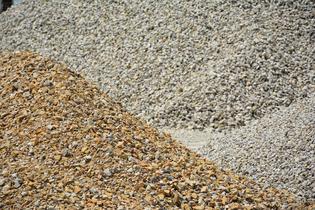Recycled Concrete
Construction materials are increasingly judged by their ecological characteristics. Concrete recycling gains importance because it protects natural resources and eliminates the need for disposal by using the readily available concrete as an aggregate source for new concrete or other applications. According to a 2004 FHWA study, 38 states recycle concrete as an aggregate base; 11 recycle it into new portland cement concrete. The states that do use recycled concrete aggregate (RCA) in new concrete report that concrete with RCA performs equal to concrete with natural aggregates. Most agencies specify using the material directly in the project that is being reconstructed.
Recycling of concrete is a relatively simple process. It involves breaking, removing, and crushing existing concrete into a material with a specified size and quality.
The quality of concrete with RCA is very dependent on the quality of the recycled material used. Reinforcing steel and other embedded items, if any, must be removed, and care must be taken to prevent contamination by other materials that can be troublesome, such as asphalt, soil and clay balls, chlorides, glass, gypsum board, sealants, paper, plaster, wood, and roofing materials.
Applications
In general, applications without any processing include:

- many types of general bulk fills
- bank protection
- base or fill for drainage structures
- road construction
- noise barriers and embankments
Most of the unprocessed crushed concrete aggregate is sold as 1½ inches or 2 inches fraction for pavement subbases.
After removal of contaminants through selective demolition, screening, and /or air separation and size reduction in a crusher to aggregate sizes, crushed concrete can be used as: new concrete for pavements, shoulders, median barriers, sidewalks, curbs and gutters, and bridge foundations structural grade concrete soil-cement pavement bases lean-concrete or econo-crete bases and bituminous concrete.
Recycled Aggregate Characteristics
The crushing characteristics of hardened concrete are similar to those of natural rock and are not significantly affected by the grade or quality of the original concrete. Recycled concrete aggregates produced from all but the poorest quality original concrete can be expected to pass the same tests required of conventional aggregates.
Recycled concrete aggregates contain not only the original aggregates, but also hydrated cement paste. This paste reduces the specific gravity and increases the porosity compared to similar virgin aggregates. Higher porosity of RCA leads to a higher absorption.
